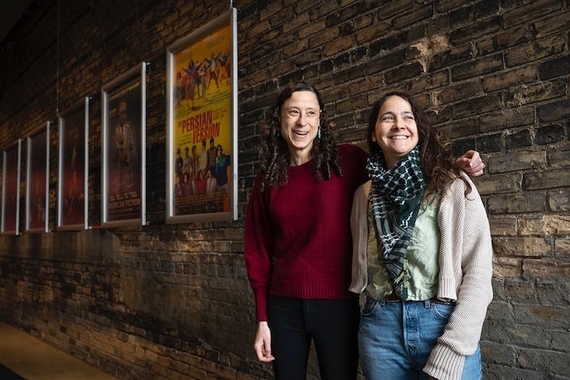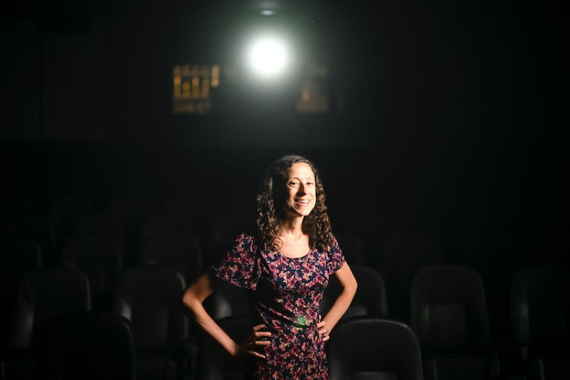Art Supplies & Propaganda: The YMCA’s Influence over POWs after WWI
Following World War I, the YMCA went to prisoner-of-war camps in Siberia to keep the prisoners busy, but also to “ensure they were not seduced by the Bolsheviks,” explains Dylan Mohr, a PhD candidate in cultural studies and comparative literature (CSCL). To this end, the YMCA gave them a variety of art supplies, books, musical instruments, film screenings, and other “wholesome” entertainment. Mohr concludes, “The YMCA wanted to cultivate ‘American values’ on the prisoners, as opposed to the ‘nonexistent values’ in camps, or worse (in the eyes of the YMCA), the values of Bolshevism.”
In one camp, the prisoners used the supplies to make a lantern slideshow. They hand-painted about 30 glass slides, which created a narrative story to project on the wall of the barracks at night. This kept the prisoners away from the Bolsheviks—but did not exactly provide the wholesome entertainment envisioned by the YMCA. “The plot of the slides showed a prisoner (called the Pleni—Russian for prisoner) being repatriated back to Central Europe,” Mohr explains. “The Pleni and his fellow prisoners run out of the camp, board a ship in Vladivostok, sail east toward the Suez Canal and on to Europe, including all kinds of crazy debauchery along the way.”
A Happy Accident
Mohr initially planned to write his dissertation on post-Soviet literature, but he changed direction after taking Associate Professor Alice Lovejoy’s course on the history of the moving image, which brought him to the Kautz Family YMCA Archives in Andersen Library. “It's really amazing the collections they have in Andersen. I hope people understand how good they are,” Mohr quips. It was there that he discovered the lantern slideshow.
The slideshow challenged the established narrative of how the YMCA interacted with prisoners of war—and Mohr knew he had to learn more about it. “I started to see that important things were going on in those camps, such as 20th-century political theory being tested there before being put into practice on a greater scale after the war,” he explains. “What interests me is how each side—the Soviets and the US—sought to reform the minds of these prisoners.”
Much of Mohr’s research focuses on how the YMCA brought aid and education to prison camps, but also propaganda—and how the prisoners reacted to it. The YMCA gave prisoners the technology to create lantern slideshow films that they hoped would reflect its political agenda, but POWs chose to use it for nighttime entertainment instead.
Exploring Other Collections
Mohr’s research has taken him from Minnesota to Austria, Russia, and France, as well as to archives at Yale University and the Jewish Joint Distribution Archives in New York. He looks forward to conducting further research in Vienna in the coming academic year, through which he hopes to track down more information about Ferdinand Ulrich and Eduard Pechatchek, the two Austrian men who created the slideshow of Pleni’s adventures.
He’s already learned that they were officers, rather than enlisted men, which “matters in terms of who had to do manual labor in the camps and who just sat around,” and that Ulrich eventually found his way back home to Austria, while Pechatchek ended up in Italy. Mohr wants to know more about their stories and “whether the YMCA initiatives actually influenced who and what they became,” he says. “The fact that one became a priest does make it seem that there was some influence there. However, the slideshow makes that influence questionable at best.”
Mohr is also curious to know whether anything else from their time as prisoners of war has survived. He recently traveled to Paris to see a personal collection of art that some prisoners sent to a YMCA secretary as gifts. The collection is held by Suzanne Teeuwissen, that secretary’s granddaughter. Mohr learned about the collection through his colleague Lena Radauer, a PhD candidate at Albert-Ludwigs-Universität in Freiburg. Mohr said when he reached out to Teeuwissen, “she was just so excited that anyone was interested in what she had.” She invited Radauer and Mohr to see her, and they ended up putting on an exhibition of the artwork from Teeuwissen’s collection in fall 2018. Radauer curated the exhibition, while Mohr provided input on the historical context. He hopes to bring the exhibit to campus at Andersen Library to share the collection and his dissertation with the general public in partnership with the YMCA archive.
Decoding the Archive
Prior to graduate school, Mohr worked as an archivist for a historical society. His archival work influenced how he receives and understands the documents he uses in his dissertation research, as it taught him that each archive has a unique motivation and is organized by human hands with human intentions. Mohr explains that many people do not realize that archives are not algorithmically organized by a computer, but rather are curated by real people.
As an example of how the personal influences of archivists influence how information is stored, Mohr cites the case of an unnamed Black slave who appeared multiple times in the Andrew Jackson name file in a Wisconsin Historical Society archive. Archives use name files to organize specific people. Mohr explains that “somebody made a decision along the way to say this unnamed Black man is going in this file now, and, thus, if you want to know any information about Andrew Jackson's slave, you would have to know the logic of the archivist who said these things should go together. Therefore, the archive has its own code.”
This understanding has given Mohr a different outlook on every archive in which he has researched. A key part of his approach involves interpreting an archive’s mission statement. Each archive crafts a statement describing who the archive is for and what story it wants to tell about the information, documents, images, films, and art it holds. For example, the statement in the Kautz Family YMCA archive positively promotes the YMCA’s history, regardless of how “good” it actually was. This is not necessarily problematic, but it is something that Mohr keeps in mind while researching in or visiting archives.
Designing His Future
As a recipient of many awards, Mohr has found a meaningful network of support at UMN, adding “I have been generously supported in this research by the Center for Austrian Studies, the Harold Leonard Memorial Fellowship in Film Studies, the Hella Mears Fellowship, and the Doctoral Dissertation Fellowship.”
After completing his dissertation, Mohr hopes to continue teaching, as he does in the CSCL department now. “One of the amazing things about CSCL is that graduate students get to design their own courses. I get to teach about topics I’m interested in and it's so fun to see students engage with them, too.” Mohr adds, “Having a student argue with you is fantastic. I wish more of them would do it. I learn so much from my students.”
This story was written by an undergraduate student in CLAgency. Meet the team.



